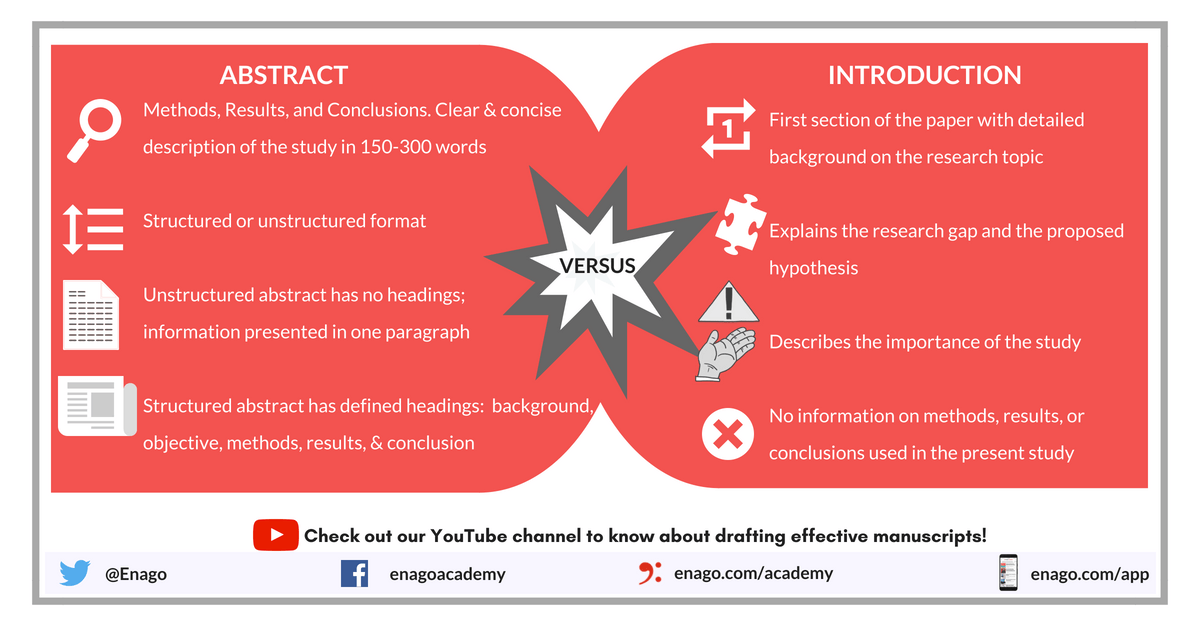

Abstract Vs. Introduction — Do you know the difference?
Ross wants to publish his research. Feeling positive about his research outcomes, he begins to draft his manuscript. After completing the abstract, he proceeds to write the introduction. That’s when he pauses in confusion. Do the abstract and introduction mean the same? How is the content for both the sections different?
This is a dilemma faced by several young researchers while drafting their first manuscript. An abstract is similar to a summary except that it is more concise and direct. Whereas, the introduction section of your paper is more detailed. It states why you conducted your study, what you wanted to accomplish, and what is your hypothesis.
This blog will allow us to learn more about the difference between the abstract and the introduction.
What Is an Abstract for a Research Paper?
An abstract provides the reader with a clear description of your research study and its results without the reader having to read the entire paper. The details of a study, such as precise methods and measurements, are not necessarily mentioned in the abstract. The abstract is an important tool for researchers who must sift through hundreds of papers from their field of study.
The abstract holds more significance in articles without open access. Reading the abstract would give an idea of the articles, which would otherwise require monetary payment for access. In most cases, reviewers will read the abstract to decide whether to continue to review the paper, which is important for you.
Your abstract should begin with a background or objective to clearly state why the research was done, its importance to the field of study, and any previous roadblocks encountered. It should include a very concise version of your methods, results, and conclusions but no references. It must be brief while still providing enough information so that the reader need not read the full article. Most journals ask that the abstract be no more than 200–250 words long.
Format of an Abstract
There are two general formats — structured and unstructured. A structured abstract helps the reader find pertinent information very quickly. It is divided into sections clearly defined by headings as follows:
- Background : Latest information on the topic; key phrases that pique interest (e.g., “…the role of this enzyme has never been clearly understood”).
- Objective : The research goals; what the study examined and why.
- Methods : Brief description of the study (e.g., retrospective study).
- Results : Findings and observations.
- Conclusions : Were these results expected? Whether more research is needed or not?
Authors get tempted to write too much in an abstract but it is helpful to remember that there is usually a maximum word count. The main point is to relay the important aspects of the study without sharing too many details so that the readers do not have to go through the entire manuscript text for finding more information.
The unstructured abstract is often used in fields of study that do not fall under the category of science. This type of abstracts does not have different sections. It summarizes the manuscript’s objectives, methods, etc., in one paragraph.
Related: Create an impressive manuscript with a compelling abstract. Check out these resources and improve your abstract writing process!
Lastly, you must check the author guidelines of the target journal. It will describe the format required and the maximum word count of your abstract.
What Is an Introduction?
Your introduction is the first section of your research paper . It is not a repetition of the abstract. It does not provide data about methods, results, or conclusions. However, it provides more in-depth information on the background of the subject matter. It also explains your hypothesis , what you attempted to discover, or issues that you wanted to resolve. The introduction will also explain if and why your study is new in the subject field and why it is important.
It is often a good idea to wait until the rest of the paper is completed before drafting your introduction. This will help you to stay focused on the manuscript’s important points. The introduction, unlike the abstract, should contain citations to references. The information will help guide your readers through the rest of your document. The key tips for writing an effective introduction :
- Beginning: The importance of the study.
- Tone/Tense: Formal, impersonal; present tense.
- Content: Brief description of manuscript but without results and conclusions.
- Length: Generally up to four paragraphs. May vary slightly with journal guidelines.

Once you are sure that possible doubts on the difference between the abstract and introduction are clear, review and submit your manuscript.
What struggles have you had in writing an abstract or introduction? Were you able to resolve them? Please share your thoughts with us in the comments section below.
Insightful and educating Indeed. Thank You
Quite a helpful and precise for scholars and students alike. Keep it up…
thanks! very helpful.
thanks. helped
Greeting from Enago Academy! Thank you for your positive comment. We are glad to know that you found our resources useful. Your feedback is very valuable to us. Happy reading!
Really helpful as I prepare to write the introduction to my dissertation. Thank you Enago Academy
This gave me more detail finding the pieces of a research article being used for a critique paper in nursing school! thank you!
The guidelines have really assisted me with my assignment on writing argument essay on social media. The difference between the abstract and introduction is quite clear now for me to start my essay…thank you so much…
Quite helpful! I’m writing a paper on eyewitness testimony for one of my undergraduate courses at the University of Northern Colorado, and found this to be extremely helpful in clarifications
This was hugely helpful. Keep up the great work!
This was quite helpful. Keep it up!
Very comprehensive and simple. thanks
As a student, this website has helped me greatly to understand how to formally report my research
Thanks a lot.I can now handle my doubts after reading through.
thanks alot! this website has given me huge clarification on writing a good Introduction and Abttract i really appreciate what you share!. hope to see more to come1 God bless you.
Thank you, this was very helpful for writing my research paper!
That was helpful. geed job.
Thank you very much. This article really helped with my assignment.
Woohoo! Amazing. I couldnt stop listening to the audio; so enlightening.
Thank you for such a clear breakdown!
I am grateful for the assistance rendered me. I was mystified over the difference between an abstract and introduction during thesis writing. Now I have understood the concept theoretically, I will put that in practice. So thanks a lots it is great help to me.
Rate this article Cancel Reply
Your email address will not be published.

Enago Academy's Most Popular Articles

- AI in Academia
- Infographic
- Manuscripts & Grants
- Reporting Research
- Trending Now
Can AI Tools Prepare a Research Manuscript From Scratch? — A comprehensive guide
As technology continues to advance, the question of whether artificial intelligence (AI) tools can prepare…

- Old Webinars
- Webinar Mobile App
Demystifying Research Methodology With Field Experts
Choosing research methodology Research design and methodology Evidence-based research approach How RAxter can assist researchers

- Manuscript Preparation
- Publishing Research
How to Choose Best Research Methodology for Your Study
Successful research conduction requires proper planning and execution. While there are multiple reasons and aspects…

Top 5 Key Differences Between Methods and Methodology
While burning the midnight oil during literature review, most researchers do not realize that the…

如何准备高质量的金融和科技领域学术论文
如何寻找原创研究课题 快速定位目标文献的有效搜索策略 如何根据期刊指南准备手稿的对应部分 论文手稿语言润色实用技巧分享
How to Draft the Acknowledgment Section of a Manuscript
Discussion Vs. Conclusion: Know the Difference Before Drafting Manuscripts
Annex Vs. Appendix: Do You Know the Difference?

Sign-up to read more
Subscribe for free to get unrestricted access to all our resources on research writing and academic publishing including:
- 2000+ blog articles
- 50+ Webinars
- 10+ Expert podcasts
- 50+ Infographics
- 10+ Checklists
- Research Guides
We hate spam too. We promise to protect your privacy and never spam you.
- Industry News
- Promoting Research
- Career Corner
- Diversity and Inclusion
- Infographics
- Expert Video Library
- Other Resources
- Enago Learn
- Upcoming & On-Demand Webinars
- Open Access Week 2024
- Peer Review Week 2024
- Conference Videos
- Enago Report
- Journal Finder
- Enago Plagiarism & AI Grammar Check
- Editing Services
- Publication Support Services
- Research Impact
- Translation Services
- Publication solutions
- AI-Based Solutions
- Thought Leadership
- Call for Articles
- Call for Speakers
- Author Training
- Edit Profile
I am looking for Editing/ Proofreading services for my manuscript Tentative date of next journal submission:

Which among these would you prefer the most for improving research integrity?

Community Blog
Keep up-to-date on postgraduate related issues with our quick reads written by students, postdocs, professors and industry leaders.
Abstract vs Introduction – Differences Explained

- By Dr Harry Hothi
- August 29, 2020

Any academic write up of a research study or project will require the inclusion of an abstract and introduction. If you pick up any example of a research paper for a journal, dissertation for a Masters degree or a PhD thesis, you’ll see the abstract, followed by the introduction. At first glance you’ll notice that the abstract is much shorter in length, typically a quarter or third of a page of A4. The introduction on the other hand is longer, taking up at least an entire page of writing.
Beyond the length, what are the differences in the content of the two sections? In short, the abstract is a summary of the entire study, describing the context, research aim, methods, results and key conclusions. The introduction gives more detail on the background of the subject area, the motivation for the study and states the aims and objectives.
Read on to learn more.
What is an Abstract?
The main purpose of an abstract is to succinctly give the reader an overview of why the study was needed, what the purpose of the project was, the research question, the key materials and methods that were used, the main results and what conclusions were drawn from this. Many abstracts also conclude with a sentence on the significance or impact of the research. These are sometimes also referred to as an executive summary.
The reader should have an understanding of the paper topic and what the study was about from the abstract alone. He or she can then decide if they want to read the paper or thesis in more detail.
Abstracts are particularly useful for researchers performing a literature review, which involves critically evaluating a large number of papers. Reading the abstract enables them to quickly ascertain the key points of a paper, helping them identify which ones to read in full.
Abstracts are also very important for learning more about the work performed in papers that are hidden behind academic journal paywalls (i.e. those that are not open access). Abstracts are always made freely available, allowing a researcher to understand the context and main point of the work and then decide if it’s worth paying to read the entire paper. These are sometimes referred to as the ‘de facto introduction’ to the research work as it’s usually the first section people read about your study, after the title page.
How do you Write an Abstract?
The majority of academic journals place a limit of 250 words on the length of the abstract in papers submitted to them. They do this to ensure you give a quick overview of only the most important information from your study, helping the reader decide if they want to read the whole paper too. Make sure you double check the specific requirements of your target journal before you start writing.
Universities or other academic institutions often allow up to 500 words for an abstract written for a doctoral thesis.
Abstracts can be either structured or unstructured in the way they are formatted. A structured abstract contains separate headings to guide the reader through the study. Virtually all STEM journals will require this format be used for a researcharticle. The exact names used for each heading can differ but generally there are defined as:
- Background. This is also sometimes called the Introduction. This section should give an overview of what is currently known about the research topic and what the gap in knowledge is. The reader should understand the problem your research will address; i.e. what was your study needed. Don’t include any references or citations in the abstract.
- Aim and Objective. Give a brief explanation of what the study intended to achieve and state the research question or questions that you proposed. Some authors also include the hypothesis here too.
- Materials and Methods. Use the methods section to describe what you investigated, what the study design was and how you carried it out.
- Results. Give an overview of your key findings.
- Discussion and Conclusion. Some journals may ask for these two terms to be used as separated headings. These sections explain why you may have obtained the results that you did, what this means and what the significance or impact of this might be.
An informative abstract should provide a concise summary of all the important points in your research project, including what the central question relating to the subject matter was. Make it interesting to read too; this may be the difference between your abstract being accepted or rejected if you decide to submit it to an upcoming conference. Reviewers for large conferences often have to read hundreds of abstracts so make sure yours stands out by being easy to read and follow.
It’s less common that you’ll be asked to write an unstructured abstract. If you are, however, be aware that the key difference is that an unstructured abstract does not include separate headings. The flow of the abstract text should still follow the 5 points listed above but they should all be written within one long paragraph.
What is the Introduction?
The introduction section is the first main written work presented after the abstract in your paper manuscript or thesis. In a research paper, the introduction will be followed by a section on the materials and methods. In thesis writing, the introduction will be followed by the literature review .
The main aim of introduction writing is to give the reader more detail on the background information of the study. It should include a brief description of the key current knowledge that exists based on the work presented in previous literature and where the gaps in knowledge are. The introduction should convey why your research was needed in order to add new understanding to your subject area. Make sure that you reference all the publications that you refer to.
When writing an introduction for a scientific paper you should also include the aim of your study and the research objectives/questions. If relevant, also include your hypothesis or (null hypothesis).
How do you Structure the Introduction?
The general rule of thumb for a research paper is to use size 12 Times New Roman font, double spaced. Write four separate paragraphs which together are no longer than one page in length. Structure the four paragraphs as follows:
- Set the context of the research study, giving background information about the subject area.
- Describe what is currently know from previously published work and what is poorly understood – i.e. the research gap.
- Explain how addressing this gap in knowledge is important for your research field – i.e. why this study is needed.
- Give a broad overview of the aims, objectives and hypothesis of the study.
You should not describe the research method used in this section nor any results and conclusions.
You should be clear now on what the differences between an abstract vs introduction are. The best way to improve your academic writing skills for these are to read other examples from other research articles and start writing!

Self-plagiarism is when you try and pass off work that you’ve previously done as something that is completely new.

The term rationale of research means the reason for performing the research study in question.

This article will answer common questions about the PhD synopsis, give guidance on how to write one, and provide my thoughts on samples.
Join thousands of other students and stay up to date with the latest PhD programmes, funding opportunities and advice.


Browse PhDs Now

A science investigatory project is a science-based research project or study that is performed by school children in a classroom, exhibition or science fair.

Are you always finding yourself working on sections of your research tasks right up until your deadlines? Are you still finding yourself distracted the moment

Dr Jadavji completed her PhD in Medical Genetics & Neuroscience from McGill University, Montreal, Canada in 2012. She is now an assistant professor involved in a mix of research, teaching and service projects.

Dr Clarence gained her PhD in Higher Education Studies from Rhodes University, South Africa in 2013. She is now an honorary research associate at the University and also runs her own blog about working as a researcher/parent in academia.
Join Thousands of Students

Submit Manuscript
Easy Online Form
Get Newsletter
Sign Up Today
Abstract vs. Introduction: What’s the Difference?
Home » Writing the Manuscript » Abstract vs. Introduction: What’s the Difference?

The main difference between and abstract and an introduction is that the abstract is a brief summary of your entire study—the aim or objective, methods, results, and conclusions—usually in that order. It gives the highlights of your work, with only the briefest background information. Here we explain the abstract vs, introduction. If you want more details, see our blog here .
The introduction includes only some elements of what is in an abstract. In the abstract, you will expend the fewest words possible on the aims or objective section that opens it, just enough to let your reader know your research question. In the introduction, you will expand on the trail of evidence that led you to asking your research question.
What is an abstract for a research paper?
In an abstract, you summarize your work and capture the reader’s attention with the most important details about your work. Usually, you must give this information in 250 words or fewer.
The contents of the abstract
In just a couple of sentences, you start by giving your readers the background and objectives or specific aims, in just a few sentences. You then will give a few important details about the study design, number of participants or animals, treatments or interventions, controls, and so on. Then you will give the reader the most important results from your study, and end with a conclusion that communicates the most significant takeaway from those results. The language of the abstract should be as clear as possible, even to a nonspecialist.
You can find more specific information and examples of what to include in your abstract here, in this post, “ How to write an abstract for a research paper .”
What is the introduction of a research paper?
The introduction to a research paper orients your reader to the context of your study. It gives the reader just enough background to understand why you’re doing the work. Many journals require authors to keep introductions quite brief, limiting them to only 500 words or fewer in some cases. Even if a journal does not limit the length of the introduction, you should still try to be as concise as possible.
In this part of your paper, you will give the reader the chain of evidence that led you to ask the central question or questions of your study. This part of your paper does not need to give every single detail or cite every study in the field. You need only to walk the reader through the evidence that leads to your own study question or hypothesis. Usually, you will being with a general statement and then funnel down from that to your specific research question. For more specific information about writing introductions, see the blog post, “ How to write a great introduction to a research paper .”
7 differences between an abstract and an introduction
1. An abstract will include results. An introduction will almost never include results. At most, depending on the journal, you might give a sentence generalizing your findings.
2. An abstract will offer a conclusion. An introduction will almost never give the reader the main takeaway from the study findings.
3. The abstract will give some details about the methods and study design. The introduction will offer only the briefest information, such as “Here, using mice” or “In this study of patients with breast cancer.” Any details, including numerical values, will be reserved for the materials and methods section of the paper.
4. The abstract will have only a brief background section, usually consisting of a sentence or two, at most. The introduction, in contrast, will unfold this background succinctly but more expansively, giving the reader the context for why you asked the research question you did and the trail of evidence that has led to the study you performed.
5. The language in an abstract will likely be more accessible to nonspecialists reading the paper. You should avoid jargon and abbreviations as much as possible. Try to communicate your information as briefly and clearly as possible. The introduction, on the other hand, can be offer more details of interest to people in your field, and using abbreviations is OK.
6. An abstract will almost never contain reference citations. An introduction almost always will.
7. An abstract will usually run 250 words or fewer. Although some journals limit introductions to no more than 500 words, in many journals, the introduction can be longer.
A very few highest profile journals have some submission options that use the abstract as the introduction to the paper. These journals usually call these submission categories “Letters” or “Short submissions.” In such cases, the abstract serves as the introduction to the paper and is a fully referenced paragraph that both introduces the work and summarizes the results and design. You will know if this special merging of the abstract and introduction is a requirement if you consult the journal guidelines.
San Francisco Edit specializes in scientific editing in the United States. We work with scientists from all over the world.
Sign up for our newsletter, latest from the blog.

How to Define a Problem Statement in Research: The Key to a Strong Research Proposal

Why Effective Figure Legends Matter in Research Papers

Why Knowing the Difference Between Scientific Editing and Regular Editing Is Important

Mastering Journal Paper Introductions for Academic Success
- Knowledge Center
- English Grammar
- Getting Published
- Journal Submission
- Marketing Your Paper and Yourself
- Peer Reviewing a Scientific Paper
- Presenting Your Research
- Thesis vs Dissertation
- What is Scientific Editing
- Why Edit and Types of Editing
- Writing the Manuscript
- Scientific Editing
- Business Editing
- Language Editing
- Newsletters
- Testimonials
- Areas of Expertise
San Francisco Edit 1755 Jackson Street Suite 610 San Francisco, CA 94109 Email: [email protected]
Copyright © 2003-2022 San Francisco Edit. All Rights Reserved.
Join 90,000+ Scientist Who Get Useful Tips For Writing Better Manuscripts
Don't miss out on future newsletters. sign up now..

IMAGES
VIDEO